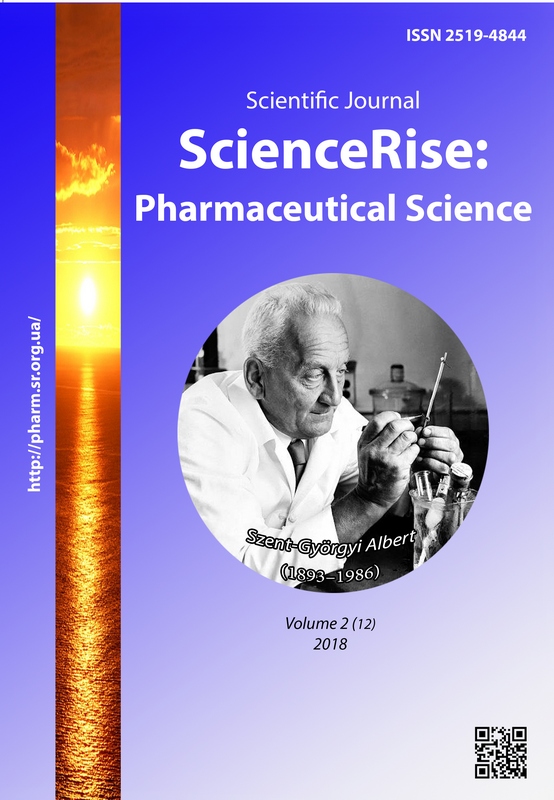Studying the influence of the natural zeolite tablets manufacturing technology on sorbtion kinetic of long-living 90Sr and 137Cs radionuclides and Pb2+ and Hg2+ heavy metals from water solution in vitro
DOI:
https://doi.org/10.15587/2519-4852.2018.128730Keywords:
natural zeolite, tablets, direct compression, wet granulation, heavy metals, radionuclides, adsorptionAbstract
Aim: To study the influence of the technology on the adsorption activity of natural zeolite tablets (clinoptilolite) in relation to long-lived 90Sr and 137Cs radionuclides and Pb2+ and Hg2+ heavy metals from an aqueous solution in vitro.
Methods: Tablets were prepared by direct pressing and pressing with pre-wet granulation (a moisturizer - 7 % starch paste). Sorption capacity of enterosorbents was investigated by the method of static sorption at pH = 2–8 at a temperature of 37 °С. The concentration of lead in solutions was determined by atomic absorption spectroscopy at the atomic absorption spectrophotometer C-115 PCS. The concentration of mercury was determined by the method of flameless atomization with the help of the mercury device PR-115. The content of radionuclides was determined by the radioactivity of the samples using a radiometer α-β-automaton NRR-610 "Tesla".
Results: Based on the results of the conducted studies, the adsorption activity of the model specimens of enterosorbents on the basis of natural zeolite in the form of tablets obtained by the technology of direct pressing and pressing with pre-wet granulation, was studied. It has been found that the sorption properties of samples relative to heavy metals and radionuclides depend to a greater extent on the acidity of the solution than on the technology of obtaining tablets. It was found that the process of ion exchange on experimental samples consists of two stages - fast and slow. This fact is explained by the adsorption of ions, primarily within the macro- and mesopor, on the material's surface, and the subsequent reduction of the velocity by diffusion of ions within the microporous space, and the last stage is limiting in the process of adsorption. Comparison of the obtained data on the sorption-selective properties of samples allowed to arrange the investigated ions in order of decreasing their interaction with sorbents Pb2+> Hg2+> 137Cs> 90Sr.
Conclusions: It is proved that the technology of obtaining tablets does not significantly affect the activity of the drug in vitro. The results of experimental studies will be used in the further development of the composition and technology of tablets containing natural zeolite (clinoptilolite) as the main active ingredient
References
- Mudgal, V., Madaan, N., Mudgal, A., Singh, R. B., Mishra, S. (2010). Effect of Toxic Metals on Human Health. The Open Nutraceuticals Journal, 3 (1), 94–99. doi: 10.2174/1876396001003010094
- Suldina, T. I. (2016). Soderzhanie tyazhelykh metallov v produktakh pitaniya i ikh vliyanie na organizm [The content of heavy metals in food and their effect on the organism]. Rational nutrition, nutritional supplements and biostimulants, 1, 136–140.
- Tarasenko, Yu. A., Gerashchenko, I. I., Kartel, N. T. (2014). Enterosorbtsiya kak metod vyvedeniya iz organizma tyazhelykh metallov i radionuklidov [Enterosorption as a method of excretion from the body of heavy metals and radionuclides]. Surface, 6, 110–121.
- Yulish, E. I., Krivuschev, B. I. (2011). Enterosorption method in the treatment of intoxication syndrome. Child’s Health, 4 (31), 25–28.
- Rybachuk, V. D., Rybachuk, D. V. (2010). Vyvchennia vplyvu dopomizhnykh rechovyn na presuiemist poroshku tseolitu pryrodnoho [Study influence of excipients on natural zeolite powder compressability]. News of Pharmacy, 3, 11–14.
- Rybachuk, V. D. (2016). Vyvchennia kinetyky utvorennia hranul tseolitu pryrodnoho pry riznykh sposobakh hranuliuvannia [The kinetic of growth of natural zeolite granules at different ways of granulation]. Annals of Mechnikov Institute, 4, 88–96.
- Kovalenko, V. N. (Ed.) (2014). Kompendium 2014 – lekarstvennye preparaty [Compendium 2014 – Pharmaceutical medicines]. Kyiv: MORION, 2448.
- Nikolaev, V. G., Gurina, N. I. (2010). Sorbtsionnye materialy i mekhanizmy deystviya [Sorption materials and mechanisms of action]. Clinical efferentology, 4. Available at: http://kiulong.com.ua/content/view/66/1/
- Campos, V. (2009). The sorption of toxic elements onto natural zeolite, synthetic goethite and modified powdered block carbon. Environmental Earth Sciences, 59 (4), 737–744. doi: 10.1007/s12665-009-0069-6
- Johan, E., Yamada, T., Munthali, M. W., Kabwadza-Corner, P., Aono, H., Matsue, N. (2015). Natural Zeolites as Potential Materials for Decontamination of Radioactive Cesium. Procedia Environmental Sciences, 28, 52–56. doi: 10.1016/j.proenv.2015.07.008
- Lurie, Yu. Yu. (1979). Spravochnik po analiticheskoy khimii [Handbook of Analytical Chemistry]. Moscow: Nauka, 480.
- Sienko, M., Pleyn, R., Khester, R. (1968). Strukturnaya neorganicheskaya khimiya [Structural inorganic chemistry]. Moscow: Mir, 344.
Downloads
Published
How to Cite
Issue
Section
License
Copyright (c) 2018 Vasiliy Rybachuk, Olena Ruban, Alla Krasnopyorova, Galina Yuhno

This work is licensed under a Creative Commons Attribution 4.0 International License.
Our journal abides by the Creative Commons CC BY copyright rights and permissions for open access journals.








